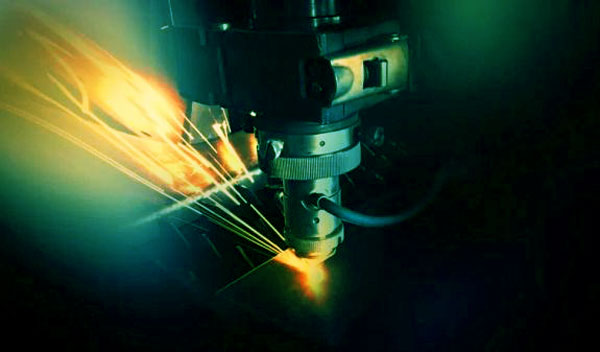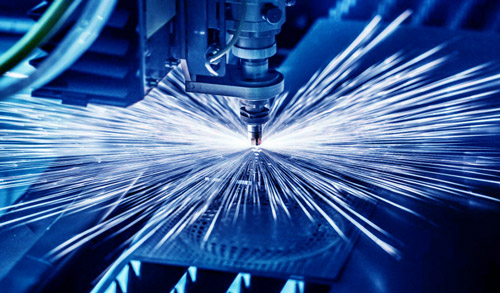首页 > NEWS > Industry News
【summary】
This paper mainly introduces the ultraviolet laser processing technology. Through experiments, the processing effects of ultraviolet/infrared laser processing materials are compared. It is found that compared with infrared laser, the ultraviolet laser has smoother processing edges and higher efficiency during processing.
This paper mainly introduces the UV laser processing technology. Through experiments, the processing effects of UV/IR laser processing materials are compared. It is found that compared with infrared laser, UV laser has smoother processing edges and higher efficiency. For infrared devices processed with materials with high infrared transmittance, UV laser has obvious advantages.

1. Introduction
In the 20th century, laser technology was one of the four great inventions along with atomic energy, semiconductors and computers. Over the past forty years, with the increasing demand for small electronic and microelectronic components, the precision processing technology of processing materials (especially polymer materials and high melting point materials) is gradually becoming one of the fastest growing areas of laser in industrial applications.
Laser processing is an important application of the laser industry. It is more precise, accurate and fast than traditional mechanical processing. It uses the interaction between laser and matter to process various materials including metals and non-metals, involving welding, cutting, marking, drilling, heat treatment, molding and other processing technologies. Its unique properties make it an ideal tool for microprocessing. It has been widely used in the three major fields of microelectronics, micromechanics and micro-optics processing.
It is a processing technology that uses the characteristics of the interaction between laser and matter to cut, weld, surface treat, punch and micro-process materials (including metals and non-metals).
Laser processing has its unique characteristics:
(1) Wide range: Any material can be engraved and cut.
(2) Safe and reliable: Non-contact processing is adopted, and the material is not subjected to mechanical extrusion or mechanical stress.
(3) Precision and fineness, with a processing accuracy of up to 0.01 mm.
(4) Consistent effect: The same processing effect is guaranteed for the same batch.
(5) High speed and fast: High-speed engraving and cutting can be performed immediately according to the computer output pattern, and the speed is faster than wire cutting.
(6) Low cost: Not limited by the number of processing, laser processing is cheaper for small batch processing services.
(7) Small cutting gap: The cutting gap of laser cutting is generally 0.02mm-0.05mm.
(8) Smooth cutting surface: There are no burrs on the laser cutting surface.
(9) Small thermal deformation: The laser cutting gap in laser processing is thin, the speed is fast, and the energy is concentrated, so the heat transferred to the cutting material is very small, resulting in small material deformation.
The materials (gems, etc.) and processing conditions (precision, deformation, etc.) used in infrared equipment technology all require laser processing. Considering that there are many types of lasers, we mainly involve infrared laser equipment and ultraviolet laser processing systems. Therefore, we hope to compare the processing effects of the same ultraviolet/infrared laser processing system on the same material through experiments, understand their characteristics and differences, and determine their scope of application and advantages, so as to lay the foundation for better development of special material processing in the future.
2. Laser device:
A 1.06 micron laser device is used for laser output, with a maximum single pulse laser energy of 60J and a frequency of 1Hz-100Hz (continuously adjustable). The laser is focused on the focal plane, and the power density on the focal plane can reach 105-1013W/cm2. Laser welding can also be used for laser welding. The laser beam has good directivity and high power density. Through the optical system, the laser beam is focused in a very small range, forming a local heat source area with highly concentrated energy in a very short time, so that the welded parts are melted to form a firm welding point and weld.
2. Ultraviolet laser drilling machine:
UV laser drilling machine uses high-power triple frequency (DPSS) laser with a wavelength of 355nm, an average power of 2.3W, a maximum frequency of 100kHz, and a spot diameter on the workpiece as small as 20渭m. This machine uses drawing software with reasonable parameter settings and can complete a series of operations such as drilling, engraving, and cutting. Experiments show that the organic materials required for this ultraviolet laser drilling process are mainly polymers, paper products, etc. Inorganic salt materials include metals, gemstones, glass, ceramics, etc.

3. Comparison of UV/infrared laser:
Infrared laser (wavelength 1.06 microns) is a widely used laser source for material processing. However, in many plastics and special polymers (such as polyimide) used as a large number of flexible circuit board substrate materials, they cannot be finely processed by infrared or "heat" treatment. Because "heat energy" deforms plastics and causes carbonization damage at the edges of cuts or drilled holes, this can lead to structural weakening and parasitic conductive pathways, and some subsequent processing steps must be added to improve processing quality. Therefore, infrared lasers are not suitable for processing certain flexible circuits. In addition, even at high energy density, copper cannot absorb the wavelength of infrared lasers, which further limits its application range.
The output wavelength of UV lasers is less than 0.4 microns, which is the main advantage of processing polymer materials.
Unlike infrared processing, UV microprocessing does not require heat treatment, and most materials absorb UV light much more easily than infrared light. High-energy UV photons directly destroy the molecular bonds on the surface of many non-metallic materials. The edges of parts processed by this cold light etching process are smooth and the degree of carbonization is minimal. In addition, the characteristics of UV short waves themselves are more favorable for mechanical microprocessing of metals and polymers. It can focus on points at the sub-micron level, so it can process tiny parts and obtain very high energy density, so that even if the pulse energy is not large, it can effectively process materials.
Micropores have been widely used in industry, and there are two main forms:
One method is to use infrared laser: heat the material on the surface of the material and evaporate (evaporate) to remove the material, this method is usually called hot processing. Laser (wavelength of 1.06渭m) is mainly used.
The other is ultraviolet laser: high-energy ultraviolet photons directly destroy the molecular bonds on the surface of many non-metallic materials, separating them from the object without generating high heat, so it is called cold processing, mainly using ultraviolet laser (wavelength of 355 nanometers).
4. Conclusion:
After comparative tests, it was found that:
(1) Laser processing is more accurate, faster and more precise than traditional mechanical processing.
(2) From the drilling test, it can be seen that ultraviolet laser has greater advantages than infrared laser in terms of processing speed, drilling accuracy and quality effect. Therefore, for some processing materials with diameter accuracy, hole surface quality requirements and high melting point of processing materials, ultraviolet laser can be used instead of infrared laser.
(3) It is not difficult to find in the cutting process that using ultraviolet laser to cut some metals, such as copper film, molybdenum sheet, etc., has the advantages of narrow cutting seam, small heat-affected range, high efficiency, etc., which is suitable for the development of various high-precision fine thin film devices. Although solid-state semiconductor pump ultraviolet laser has many advantages, how to better utilize semiconductor pump ultraviolet laser precision processing through the optimization and adjustment of process parameters is an issue that needs further discussion.
| Free solutions/free proofing 13710252340
Previous: What are the applications of p